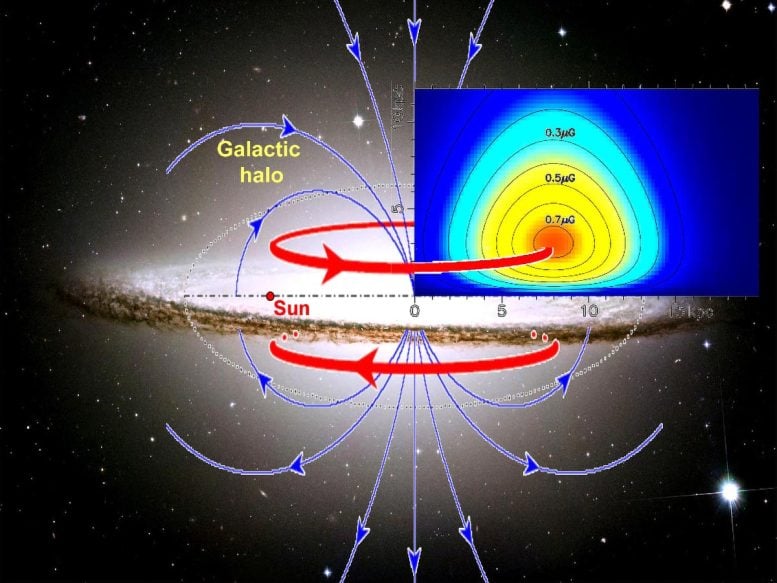I love to say "I told you so"! Yet another in a long line of scientific discoveries verifies the cosmology of A Simple Explanation of Absolutely Everything. Nice going, scientists! Here's a reprint from SciTech Daily, shared with us by a longtime ASEOAE reader. Thank you, Karl!
Galactic Rings of Power: Astronomers Uncover Massive Magnetic Toroids in the Milky Way Halo

Magnetic fields in the halo of the Milky Way have a toroidal structure, extending in the radius range of 6000 light-years to 50,000 light-years from the Galaxy center. The Sun is at about 30,000 light-years. Credit: NAOC
Astrophysicists have discovered large magnetic toroids in the Milky Way’s halo, which impact cosmic ray propagation and the physics of interstellar space. Their research, based on extensive Faraday rotation data, reveals that these toroids extend across the galaxy, confirming the presence of significant toroidal magnetic fields.
A long-standing unsolved question at the frontier of astronomy and astrophysics research is the origin and evolution of cosmic magnetic fields. It has been selected as one of the key areas of investigation for many major world-class radio telescopes, including the Square Kilometer Array (SKA) currently under construction. Determining the large-scale magnetic field structures in the Milky Way has been a major challenge for many astronomers in the world for decades.
Discovery of Magnetic Toroids
In a new study published in The Astrophysical Journal on May 10, Dr. Jun Xu and Prof. Jinlin Han from the National Astronomical Observatories of the Chinese Academy of Sciences (NAOC) have revealed huge magnetic toroids in the halo of the Milky Way, which are fundamental for cosmic ray propagation and provide crucially constraint on the physical processes in the interstellar medium and the origin of cosmic magnetic fields.
Prof. Han, a leading scientist in this research field, has determined the magnetic field structures along the spiral arms of the Galactic disk through a long-term project of measuring the polarization of pulsars and their Faraday effects. In 1997, he found a striking anti-symmetry of the Faraday effects of cosmic radio sources in the sky with respect to the coordinates of our Milky Way galaxy, which tells that the magnetic fields in the halo of the Milky Way have a toroidal field structure, with reversed magnetic field directions below and above the Galactic plane.
Challenges in Measuring Magnetic Fields
However, to determine the size of these toroids or the strength of their magnetic fields has been a tough task for astronomers for decades. They suspected that the anti-symmetry of the sky distribution of Faraday effects of radio sources could be produced merely by the interstellar medium in the vicinity of the Sun because pulsars and some nearby radio-emission objects, which are quite near to the Sun, show Faraday effects consistent with anti-symmetry. The key is to show whether or not magnetic fields in the vast Galactic halo had such a toroidal structure outside the vicinity of the Sun.
Innovative Research Methods
In this study, Prof. Han innovatively proposed that the Faraday rotation from the interstellar medium in the vicinity of the Sun could be counted by the measurements of a good number of pulsars, some of which have been obtained recently by the Five-hundred Aperture Spherical radio Telescope (FAST) by themself, and then could be subtracted the contribution from the measurements of background cosmic sources. All Faraday rotation measurement data in the past 30 years were collected by Dr. Xu.
Through data analysis, scientists found that the anti-symmetry of the Faraday rotation measurements caused by the medium in the Galactic halo exists in all the sky, from the center to the anti-center of our Milky Way, which implies that the toroidal magnetic fields of such a odd symmetry have a huge size, existing in a radius range from 6000 light-years to 50,000 light-years from the center of the Milky Way.
Conclusion and Impact
This study has significantly advanced our understanding of the Milky Way’s physics and marks a milestone in research on cosmic magnetic fields.
Reference: “The Huge Magnetic Toroids in the Milky Way Halo” by J. Xu and J. L. Han, 10 May 2024, The Astrophysical Journal.
DOI: 10.3847/1538-4357/ad3a61





















